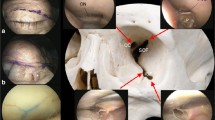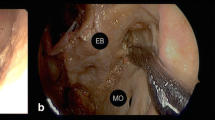Abstract
Background
Endoscopic transorbital approach (eTOA) has been announced as an alternative minimally invasive surgery to skull base. Owing to the inferior orbital fissure (IOF) connecting the orbit with surrounding pterygopalatine fossa (PPF), infratemporal fossa (ITF), and temporal fossa, the idea of eTOA to anterolateral skull base through IOF is postulated. The aim of this study is to access its practical feasibility.
Methods
Anatomical dissections were performed in five human cadaveric heads (10 sides) using 0-degree and 30-degree endoscopes. A stepwise description of eTOA to anterolateral skull base through IOF was documented. The anterosuperior corner of the maxillary sinus in the horizontal plane of the upper edge of zygomatic arch was defined as reference point (RP). The distances between the RP to the foramen rotundum (FR), foramen ovale (FO), and Gasserian ganglion (GG) were measured. The exposed area of anterolateral skull base in the coronal plane of the posterior wall of the maxillary sinus was quantified.
Results
The surgical procedure consisted of six steps: (1) lateral canthotomy with cantholysis and preseptal lower eyelid approach with periorbita dissection; (2) drilling of the ocular surface of greater sphenoid wing and lateral orbital rim osteotomy; (3) entry into the maxillary sinus and exposure of PPF and ITF; (4) mobilization of infraorbital nerve with drilling of the infratemporal surface of the greater sphenoid wing and pterygoid process; (5) exposure of middle cranial fossa, Meckel’s cave, and lateral wall of cavernous sinus; and (6) reconstruction of orbital floor and lateral orbital rim. The distances measured were as follows: RP-FR = 45.0 ± 1.9 mm, RP-FO = 55.7 ± 0.5 mm, and RP-GG = 61.0 ± 1.6 mm. In comparison with the horizontal portion of greater sphenoid wing, the superior and inferior axes of the exposed area were 22.3 ± 2.1 mm and 20.5 ± 1.8 mm, respectively. With reference to the FR, the medial and lateral axes of the exposed area were 11.6 ± 1.1 mm and 15.8 ± 1.6 mm, respectively.
Conclusions
The eTOA through IOF can be used as a minimally invasive surgery to access whole anterolateral skull base. It provides a possible resolution to target lesion involving multiple compartments of anterolateral skull base.










Similar content being viewed by others
References
Allen RC (2016) The evolving role of the oculoplastic surgeon in skull base surgery. Curr Opin Ophthalmol 27(5):402–407
Almeida JP, Omay SB, Shetty SR et al (2018) Transorbital endoscopic eyelid approach for resection of sphenoorbital meningiomas with predominant hyperostosis: report of 2 cases. J Neurosurg 128(6):1885–1895
Almeida JP, Ruiz-Trevino AS, Shetty SR, Omay SB, Anand VK, Schwartz TH (2017) Transorbital endoscopic approach for exposure of the sylvian fissure, middle cerebral artery and crural cistern: an anatomical study. Acta Neurochir 159(10):1893–1907
Aziz KM, Froelich SC, Cohen PL, Sanan A, Keller JT, van Loveren HR (2002) The one-piece orbitozygomatic approach: the MacCarty burr hole and the inferior orbital fissure as keys to technique and application. Acta Neurochir 144(1):15–24
Cebula H, Kurbanov A, Zimmer LA et al (2014) Endoscopic, endonasal variability in the anatomy of the internal carotid artery. World Neurosurg 82(6):e759–e764
Chen HI, Bohman LE, Loevner LA, Lucas TH (2014) Transorbital endoscopic amygdalohippocampectomy: a feasibility investigation. J Neurosurg 120(6):1428–1436
Dallan I, Di Somma A, Prats-Galino A et al (2017) Endoscopic transorbital route to the cavernous sinus through the meningo-orbital band: a descriptive anatomical study. J Neurosurg 127(3):622–629
Dallan I, Sellari-Franceschini S, Turri-Zanoni M et al (2018) Endoscopic transorbital superior eyelid approach for the management of selected spheno-orbital meningiomas: preliminary experience. Oper Neurosurg (Hagerstown) 14(3):243–251
De Battista JC, Zimmer LA, Theodosopoulos PV, Froelich SC, Keller JT (2012) Anatomy of the inferior orbital fissure: implications for endoscopic cranial base surgery. J Neurol Surg B Skull Base 73(2):132–138
de Lara D, Ditzel Filho LF, Prevedello DM et al (2014) Endonasal endoscopic approaches to the paramedian skull base. World Neurosurg 82(6 Suppl:S121–S129
DeMonte F, Tabrizi P, Culpepper SA, Suki D, Soparkar CN, Patrinely JR (2002) Ophthalmological outcome after orbital entry during anterior and anterolateral skull base surgery. J Neurosurg 97(4):851–856
Di Somma A, Andaluz N, Cavallo LM et al (2018) Endoscopic transorbital superior eyelid approach: anatomical study from a neurosurgical perspective. J Neurosurg 129(5):1203–1216
Di Somma A, Andaluz N, Cavallo LM et al (2018) Endoscopic transorbital route to the petrous apex: a feasibility anatomic study. Acta Neurochir 160(4):707–720
Elhadi AM, Zaidi HA, Yagmurlu K et al (2016) Infraorbital nerve: a surgically relevant landmark for the pterygopalatine fossa, cavernous sinus, and anterolateral skull base in endoscopic transmaxillary approaches. J Neurosurg 125(6):1460–1468
Ferrari M, Schreiber A, Mattavelli D et al (2016) The inferolateral transorbital endoscopic approach: a preclinical anatomic study. World Neurosurg 90:403–413
Fisch U, Fagan P, Valavanis A (1984) The infratemporal fossa approach for the lateral skull base. Otolaryngol Clin N Am 17(3):513–552
Harvey RJ, Sheehan PO, Debnath NI, Schlosser RJ (2009) Transseptal approach for extended endoscopic resections of the maxilla and infratemporal fossa. Am J Rhinol Allergy 23(4):426–432
Hofstetter CP, Singh A, Anand VK, Kacker A, Schwartz TH (2010) The endoscopic, endonasal, transmaxillary transpterygoid approach to the pterygopalatine fossa, infratemporal fossa, petrous apex, and the Meckel cave. J Neurosurg 113(5):967–974
Janecka IP, Sen CN, Sekhar LN, Arriaga M (1990) Facial translocation: a new approach to the cranial base. Otolaryngol Head Neck Surg 103(3):413–419
Jeon C, Hong CK, Woo KI et al Endoscopic transorbital surgery for Meckel’s cave and middle cranial fossa tumors: surgical technique and early results. J Neurosurg 1:1–10. https://doi.org/10.3171/2018.6.JNS181099
Kassam AB, Gardner P, Snyderman C, Mintz A, Carrau R (2005) Expanded endonasal approach: fully endoscopic, completely transnasal approach to the middle third of the clivus, petrous bone, middle cranial fossa, and infratemporal fossa. Neurosurg Focus 19(1):E6
Kong DS, Young SM, Hong CK et al (2018) Clinical and ophthalmological outcome of endoscopic transorbital surgery for cranioorbital tumors. J Neurosurg [epub ahead of print:1–9. https://doi.org/10.3171/2018.3.JNS173233
Labib MA, Prevedello DM, Carrau R et al (2014) A road map to the internal carotid artery in expanded endoscopic endonasal approaches to the ventral cranial base. Neurosurgery 10(Suppl 3):448–471
Landreneau FE, Mickey B, Coimbra C (1998) Surgical treatment of cerebrospinal fluid fistulae involving lateral extension of the sphenoid sinus. Neurosurgery 42(5):1101–1104
Moe KS, Bergeron CM, Ellenbogen RG (2010) Transorbital neuroendoscopic surgery. Neurosurgery 67(3 Suppl Operative):ons16–ons28
Pinheiro-Neto CD, Fernandez-Miranda JC, Prevedello DM, Carrau RL, Gardner PA, Snyderman CH (2013) Transposition of the pterygopalatine fossa during endoscopic endonasal transpterygoid approaches. J Neurol Surg B Skull Base 74(5):266–270
Ramakrishna R, Kim LJ, Bly RA, Moe K, Ferreira M Jr (2016) Transorbital neuroendoscopic surgery for the treatment of skull base lesions. J Clin Neurosci 24:99–104
Raza SM, Donaldson AM, Mehta A, Tsiouris AJ, Anand VK, Schwartz TH (2014) Surgical management of trigeminal schwannomas: defining the role for endoscopic endonasal approaches. Neurosurg Focus 37(4):E17
Reynolds JM, Tomkinson A, Grigg RG, Perry CF (1998) A Le Fort I osteotomy approach to lateral sphenoid sinus encephalocoeles. J Laryngol Otol 112(8):779–781
Schwartz TH, Fraser JF, Brown S, Tabaee A, Kacker A, Anand VK (2008) Endoscopic cranial base surgery: classification of operative approaches. Neurosurgery 62(5):991–1002
Sekhar LN, Schramm VL Jr, Jones NF (1987) Subtemporal-preauricular infratemporal fossa approach to large lateral and posterior cranial base neoplasms. J Neurosurg 67(4):488–499
Shimizu S, Tanriover N, Rhoton AL Jr, Yoshioka N, Fujii K (2005) MacCarty keyhole and inferior orbital fissure in orbitozygomatic craniotomy. Neurosurgery 57(1 Suppl):152–159
Shin SS, Gardner PA, Stefko ST, Madhok R, Fernandez-Miranda JC, Snyderman CH (2011) Endoscopic endonasal approach for nonvestibular schwannomas. Neurosurgery 69(5):1046–1057
Truong HQ, Sun X, Celtikci E et al (2018) Endoscopic anterior transmaxillary “transalisphenoid” approach to Meckel’s cave and the middle cranial fossa: an anatomical study and clinical application. J Neurosurg 130(1):227–237
Yagmurlu K, Mooney MA, Almefty KK et al (2018) An alternative endoscopic anterolateral route to Meckel’s cave: an anatomic feasibility study using a sublabial transmaxillary approach. World Neurosurg 114:134–141
Zimmer LA, Hart C, Theodosopoulos PV (2009) Endoscopic anatomy of the petrous segment of the internal carotid artery. Am J Rhinol Allergy 23(2):192–196
Funding
This work was supported by the Tri-Service General Hospital of Taiwan’s Medical Research Project (TSGH-C104-078 and TSGH-C107-071).
Author information
Authors and Affiliations
Corresponding author
Ethics declarations
Conflict of interest
The authors declare that they have no conflict of interest.
Ethical approval
All procedures performed in studies involving human participants were in accordance with the ethical standards of the institutional and/or national research committee and with the 1964 Helsinki Declaration and its later amendments or comparable ethical standards.
Informed consent
Informed consent was obtained from all individual participants included in the study.
Additional information
Publisher’s note
Springer Nature remains neutral with regard to jurisdictional claims in published maps and institutional affiliations.
This article is part of the Topical Collection on Neurosurgical Anatomy
Rights and permissions
About this article
Cite this article
Lin, BJ., Ju, DT., Hsu, TH. et al. Endoscopic transorbital approach to anterolateral skull base through inferior orbital fissure: a cadaveric study. Acta Neurochir 161, 1919–1929 (2019). https://doi.org/10.1007/s00701-019-03993-3
Received:
Accepted:
Published:
Issue Date:
DOI: https://doi.org/10.1007/s00701-019-03993-3




